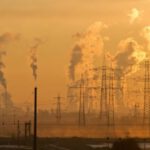Air pollution is a pressing issue that has significant implications for public health. The link between air pollution and various health risks is well-documented, with studies consistently showing the detrimental effects of polluted air on human health. From respiratory problems to cardiovascular diseases, the impact of air pollution on public health cannot be understated. Understanding how air pollution is linked to these health risks is crucial in developing strategies to mitigate its effects and protect the well-being of individuals and communities.
**The Sources of Air Pollution**
Air pollution originates from a variety of sources, both natural and human-made. Natural sources include wildfires, volcanic eruptions, and dust storms, which release particulate matter and harmful gases into the atmosphere. However, the primary contributors to air pollution are human activities such as industrial processes, transportation, agriculture, and energy production. These activities release pollutants like nitrogen oxides, sulfur dioxide, carbon monoxide, and particulate matter, which can have serious consequences for air quality and public health.
**Health Risks Associated with Air Pollution**
Exposure to air pollution has been linked to a range of health risks, impacting individuals of all ages and backgrounds. One of the most common health effects of air pollution is respiratory problems. Pollutants such as particulate matter and ozone can irritate the respiratory tract, exacerbate asthma symptoms, and increase the risk of respiratory infections. Long-term exposure to air pollution has also been associated with the development of chronic respiratory conditions such as chronic obstructive pulmonary disease (COPD).
In addition to respiratory issues, air pollution poses a significant risk to cardiovascular health. Studies have shown that exposure to air pollution can increase the risk of heart attacks, strokes, and other cardiovascular diseases. Pollutants like fine particulate matter can enter the bloodstream and trigger inflammation, leading to the narrowing of blood vessels and increased blood pressure. Over time, this can contribute to the development of cardiovascular conditions and increase the risk of cardiovascular events.
**Vulnerable Populations at Risk**
Certain populations are more vulnerable to the health effects of air pollution, including children, the elderly, individuals with pre-existing health conditions, and low-income communities. Children are particularly susceptible to the harmful effects of air pollution due to their developing respiratory systems and higher breathing rates. Exposure to polluted air in early childhood can have long-lasting effects on respiratory health and overall well-being.
Similarly, the elderly and individuals with pre-existing health conditions such as asthma, COPD, and heart disease are at a higher risk of experiencing adverse health effects from air pollution. Poor air quality can exacerbate existing health conditions and increase the likelihood of hospitalizations and mortality among these vulnerable populations. Low-income communities are also disproportionately affected by air pollution, as they are more likely to live in areas with poor air quality and limited access to healthcare resources.
**Mitigating the Health Risks of Air Pollution**
Addressing the health risks associated with air pollution requires a multi-faceted approach that involves collaboration between government agencies, healthcare providers, industries, and communities. Implementing air quality regulations and emission control measures is essential to reducing the levels of pollutants in the air and protecting public health. Investing in clean energy sources, promoting sustainable transportation options, and increasing green spaces in urban areas can also help improve air quality and mitigate the health risks of pollution.
Educating the public about the health effects of air pollution and providing information on ways to reduce exposure can empower individuals to protect themselves and their families. Simple actions such as avoiding outdoor activities during times of high pollution, using air purifiers indoors, and reducing vehicle idling can make a difference in reducing exposure to harmful pollutants. By raising awareness about the link between air pollution and public health risks, we can work towards creating a healthier environment for all.





